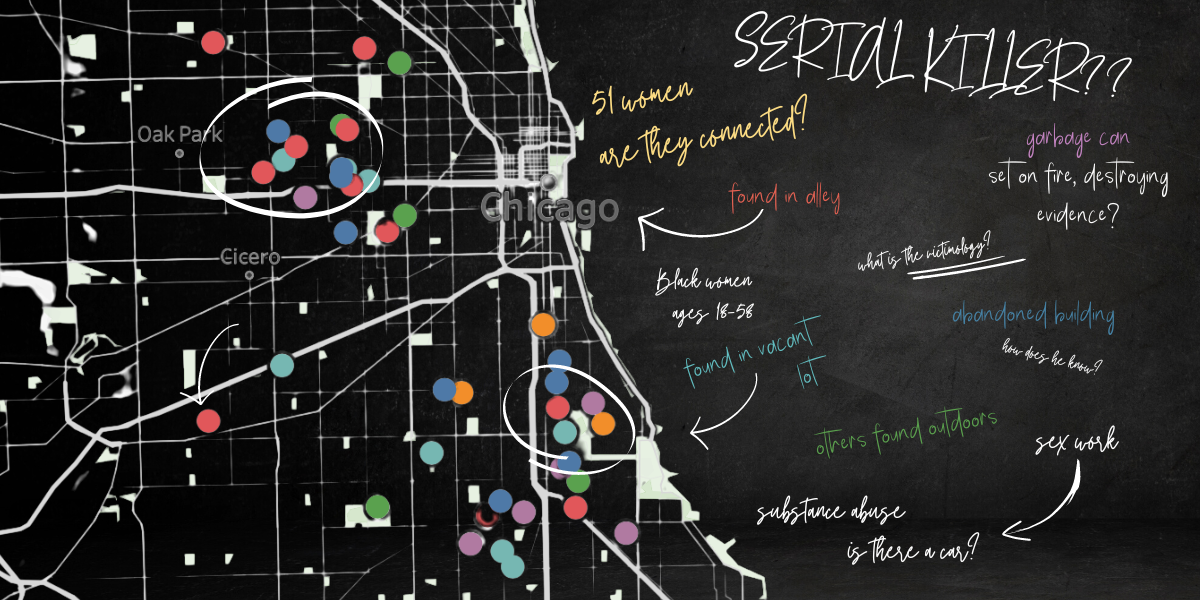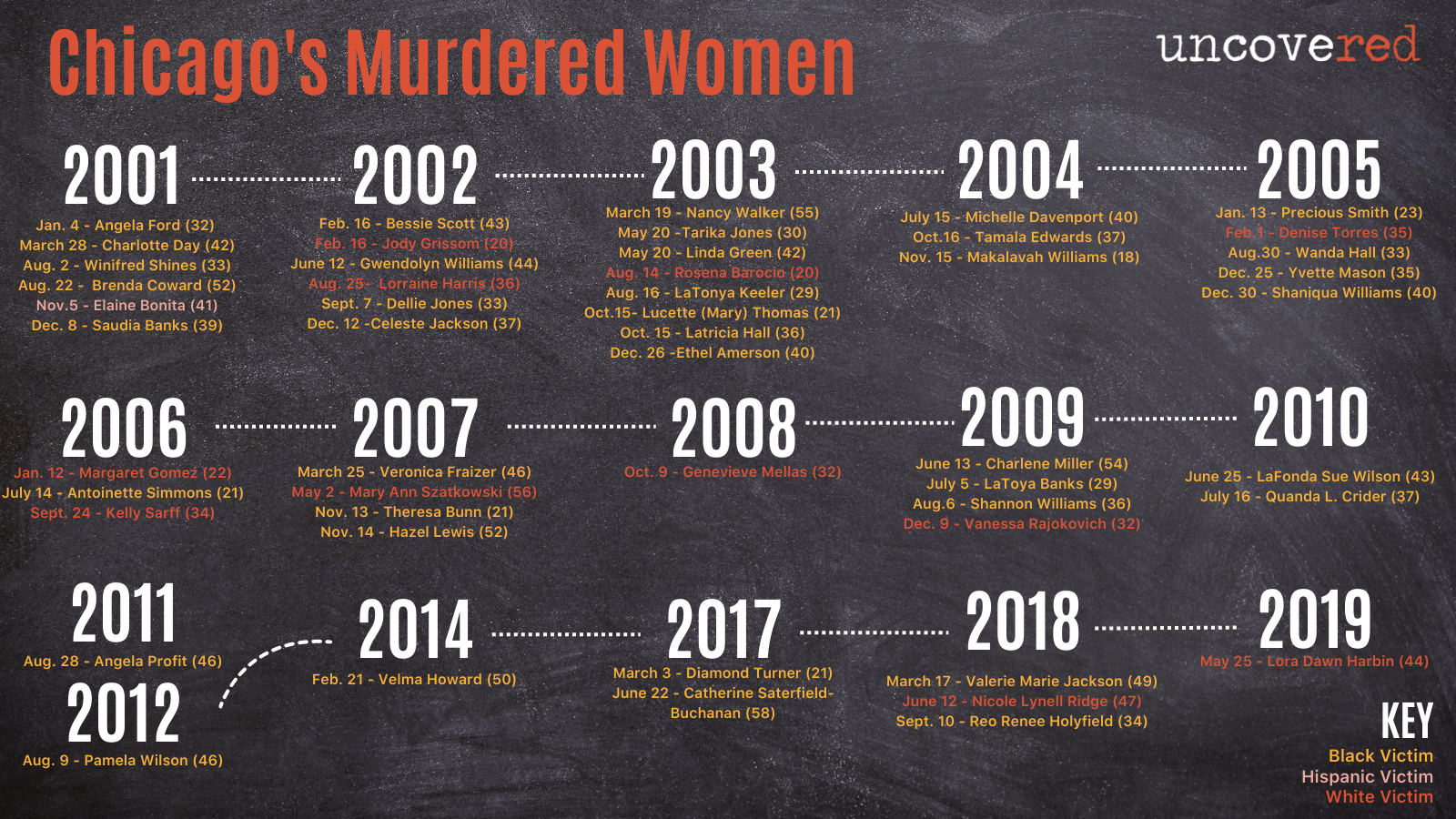By: Lexi Kakis
The Chicago Strangler is an unconfirmed serial killer — or serial killers — believed to be responsible for the deaths of countless women of color in Chicago.

Between 2001 and 2019, a disturbing trend emerged in Chicago.
Over 50 women were found strangled, their bodies heartlessly discarded in alleys, vacant lots, and abandoned buildings. The killings were spread out across several neighborhoods, but the majority occurred in the South Side of Chicago.
“The brutal nature of these crimes is very disturbing,” former Chief of Detectives Melissa Staples told the Chicago Tribune in 2018.
According to the Tribune investigation, there have been 75 women who have been strangled or smothered throughout the “Windy City” dating back to 2001. Approximately a third of those cases have been solved, but the rest remain unsolved.
Because of the striking similarities to many of the crimes, and the possibility of one or multiple serial killers, people in the media offered up a new moniker: The Chicago Strangler.
‘The Chicago Strangler’ Victimology
The murders of these women highlight the pervasive problem of violence against women — particularly women of color in vulnerable circumstances.
Many of the victims were Black, living on the margins of society, and struggling with addiction and poverty. Some were engaged in sex work as a means of survival.
The 2018 Tribune investigation discovered that the women ranged in age from 18 to 58. One of the victims was a grandmother of 20 and a great-grandmother of 2, while others were nurses, waitresses, and women actively trying to conquer their addictions.
At least 47 of the women had histories of prostitution — possibly indicating to investigators that this killer or killers seeks out women leading a high-risk lifestyle.
Unfortunately, there’s not a lot of protection that the women receive.
In speaking with the Tribune, Brenda Myers-Powell, a former sex worker who co-founded the Dreamcatcher Foundation, said, “[The work is] upfront and personal. I have been [choked] so much it became, like, you don’t let guys get close to your neck.”
These women are often ignored or overlooked by society, and their deaths are frequently dismissed or forgotten by police and the public.
It’s past time for change.
Meet Angela Ford

Angela Ford, a 32-year-old mother of two is assumed to be the first victim of a serial killer.
One of the first victims linked to these series of crimes is Angela Ford, a mother of two. In 1999, she was on her way to the local school to pick up her children’s report cards, but instead, someone violent crossed her path. Angela was found strangled, left to die in the basement of an abandoned building less than 2 miles from her home.
She wasn’t giving up without a fight.
When Angela was discovered, she was still clinging to life. She was taken to the Cook County Hospital and when her family arrived to support her, she was already placed on a death watch with a nurse stationed at her bedside.
Angela never regained consciousness.
For over a year following the tragic attack, she remained in a coma. Her family hoped and prayed that she would wake up and be able to share what happened to her. Unfortunately, Angela died on January 4, 2001.
Her cause of death was listed as strangulation.
Below is an interactive map created by the Murder Accountability Project. The map is best viewed on a computer.
Over the next few years, more women were discovered under similar circumstances.
Many of the victims were found with their hands bound and some had signs of sexual assault. Despite the alarming number of murders, police seemed slow to connect the crimes and launch a comprehensive investigation.
In 2014, police interviewed Indiana serial killer Darren Vann, who mentioned his known ties to Chicago. According to NBC Chicago 5, in an October 18, 2014, interview with police, Vann described his killings as his “mistakes” and told officers that his rage caused him to “go looking for an out.” Those “outs,” Vann said, included killings in California, Texas, Wisconsin, Minnesota and Michigan but mentioned Chicago as a place where he went a lot.
“They [Illinois] have more than Indiana,” Vann told police.
None of the leads with Vann officially panned out.
After two decades of struggling, families of the victims finally began to publicly express frustration with the police department’s handling of the cases, arguing that they have not done enough to bring the killer(s) to justice.
Thankfully, people in the media started to listen — but it hasn’t been the media wildfire many advocates had hoped for.
Media Coverage
In 2018, there was a renewed effort to shine a light on these stories after the Murder Accountability Project’s algorithm noticed a pattern with these cases. This pattern implied the likelihood of a serial killer, however, some believe these crimes could be the result of multiple serial offenders.
In 2019, the Chicago Police announced they created a specialized task force comprised of six detectives to work alongside the FBI to review these cases. According to the Chicago Reader, less than half of the victims had DNA collected and out of the DNA that was tested it resulted in 21 different male profiles. Interestingly, the task force was able to solve 4 cases but felt charges could only be applied to one of the suspects.
In January 2020, DNA evidence came back connecting Diamond Turner’s boyfriend, Arthur Hillard to her murder. 21-year-old, Diamond was found in a garbage bin in an alley in 2017. Hillard’s DNA also linked him to a 2019 fatal stabbing.
Sadly, there has been incredibly limited media coverage about these women and their stories.
Thanks to the work of local community activists and Unforgotten 51, a website created by Richmond University Journalism students, traction is starting to pick up.
In 2021, a new Discovery+ special called “The Hunt for the Chicago Strangler” dove deep into the investigations, and shed a light on the systemic racism backdrop that these cases have endured.
The Black Girl Gone Podcast has a two-part episode weaving together the timeline of the crimes and shining a light on who the victims were.
Know Their Names
We need your help filling in the gaps in these cases. Currently, we have 10 cases listed in our database, but recognize the importance of adding all of the victims to tell the full story. We’ve created a dedicated resource page listing the victims, and will continue to update links for our case cards as they are added. We encourage the public to help us in our efforts by submitting these cases to our database and helping us build out these cases.
Love this post? Meet the Author.
Lexi Kakis is the Community Engagement Manager at Uncovered. Lexi studied Media Communications at Molloy University, where she focused on television production and content creation. She has since shifted her focus toward advocating for cold cases. Lexi believes that justice has no expiration.

